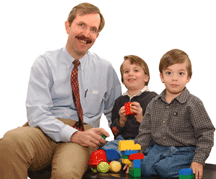 In 2002, the department of Pediatric Surgery reached the 100th transplant mark for both kidney and liver transplantations since the inception of the programs. Over the past two years, minimally invasive procedures have more than doubled. Joseph Janik, MD, a pediatric surgeon, and Michael Handler, MD, a pediatric neurosurgeon, led the 60-member surgical team that performed the separation of the Stark conjoined twins. The department has performed more Kasai procedures for the treatment of biliary atresia and more Nuss procedures for the treatment of pectus excavatum than any other group or hospital in the region. Since 2000, the number of patients admitted through the trauma program has increased 19 percent. The Children’s Hospital is the region’s only Level I pediatric trauma center.
In 2002, the department of Pediatric Surgery reached the 100th transplant mark for both kidney and liver transplantations since the inception of the programs. Over the past two years, minimally invasive procedures have more than doubled. Joseph Janik, MD, a pediatric surgeon, and Michael Handler, MD, a pediatric neurosurgeon, led the 60-member surgical team that performed the separation of the Stark conjoined twins. The department has performed more Kasai procedures for the treatment of biliary atresia and more Nuss procedures for the treatment of pectus excavatum than any other group or hospital in the region. Since 2000, the number of patients admitted through the trauma program has increased 19 percent. The Children’s Hospital is the region’s only Level I pediatric trauma center.
Frederick M. Karrer, MD
Chairman with four-year-old
Jack and two-year-old Allen
 One of the Top Pediatric Liver and Kidney Transplant Centers in the Country
One of the Top Pediatric Liver and Kidney Transplant Centers in the Country
In 2002, the 100th liver transplant mark was surpassed. This winter, the surgical group also passed the 100th kidney transplant mark. Multidisciplinary pediatric transplant teams transplanted 16 kidneys in 2002 and 15 livers. Both the Liver Center and the Kidney Center offer patients and their families a depth of expertise from initial evaluation through surgery and ongoing postoperative care.
Minimally Invasive Surgery
Over the past two years, minimally invasive procedures have increased from 400 procedures during 1999/2000 to more than 850 procedures in 2001/2002. In 2001, David Partrick, MD, joined the Pediatric Surgery staff as director of endoscopy. The increase in minimally invasive surgery at Children’s is largely due to broader applications for minimally invasive techniques and advances in technology allowing these procedures to be performed on smaller and sicker infants and children.
In the spring of 2002, the hospital opened three additional operating rooms, two of which are state-of-the-art pediatric endoscopy suites.To offer the latest, most advanced minimally invasive surgery, the hospital is evaluating robotic systems. These robots not only give surgeons more precision and dexterity when performing minimally invasive procedures, but also accelerate the learning curve for pediatric surgeons interested in minimally invasive surgery.
Kasai and Nuss Procedures
As one of the pioneers of the Kasai procedure for the treatment of biliary atresia, the hospital is one of the most experienced surgical centers in the country for the Kasai. Fritz Karrer, MD, is nationally recognized as an expert in the procedure.
The Nuss procedure for the treatment of pectus excavatum or “sunken chest” has been performed more than 50 times at Children’s by Drs. Bensard, Janik and Partrick. The procedure involves popping the depressed sternum into a neutral position and supporting the sternum with the specially designed metal bar. The result is a larger thorax for pulmonary function. The Nuss procedure accomplishes this through two, small lateral thoracic incisions and with a minimum of surgical manipulations.
Level I Pediatric Trauma Center
Because The Children’s Hospital is the Regional Pediatric Trauma Center, about 70 percent of trauma patients are transferred from other hospitals and clinics. In 2002, Trauma Services saw young patients from seven western states: Colorado, Kansas, Montana, Nebraska, New Mexico, South Dakota and Wyoming. The trauma program treated 1,592 patients in 2001/2002. Since 2000, the number of patients admitted through the trauma program has increased 19 percent. The hospital also serves as the regional pediatric burn center.
Education and Training
The pediatric surgery department has had a general surgery training program since 1993. The department actively trains residents from the University of Colorado School of Medicine and Exempla Saint Joseph’s Hospital programs.
The pediatric surgeons are active in community outreach. In addition to providing talks to primary care physicians, the surgeons speak to high school and community groups about current surgery issues. Dr. Janik, who led the surgical team for the Stark conjoined twins separation, continues to provide teaching and training specific to the twins. His presentations have included nine media interviews and documentaries.
Our surgeons are meeting the changing needs of our rapidly growing community by holding clinics at satellite locations. Surgeons see patients at Aurora, Centennial, Littleton and Broomfield.
Research
Current research topics include several trauma studies including inflammatory response to trauma in children, several biliary atresia-related studies and expanded clinical outcome studies.
Future
Recruitment of additional surgeons is planned within the next several years. Growth is expected in the liver and kidney transplant programs with the training of a surgery fellow in transplantation surgery. With the two new endoscopic operating suites and the advancements in robotic surgery, the development of the department’s minimally invasive capabilities are expected to accelerate. Research opportunities are also expected to expand, particularly in pediatric oncologic research and clinical outcomes research.

